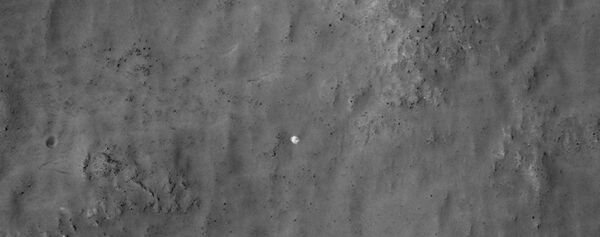WASHINGTON, April 12 (RIA Novosti) – A group of Russian space followers think they have spotted the remnants of a Soviet spacecraft that made the first successful soft landing on Mars more than 40 years ago in an image from 2007 taken by NASA’s Mars Reconnaissance Orbiter.
“While following news about Mars and NASA’s Curiosity rover, Russian citizen enthusiasts found four features in a 5-year-old image from Mars Reconnaissance Orbiter that resemble four pieces of hardware from the Soviet Mars 3 mission: the parachute, heat shield, terminal retrorocket and lander,” NASA said in a statement.
The Soviet space program’s Mars 3 mission made a soft landing on the Red Planet on December 2, 1971 and sent data back to earth for 14.5 seconds before the transmissions stopped abruptly.
When Russian space aficionado Vitali Egorov saw an image taken by NASA’s Mars Reconnaissance Orbiter of the crater where Mars 3 was believed to have landed, he made models of what key pieces of the Soviet spacecraft would have looked like and got members of an online community that follows NASA’s Curiosity rover to look for objects in the image that matched his models.
The group identified four specks in the bottom part of the image from the MRO that they thought might be Mars 3’s heat shield, parachute, retrorocket and lander.
Alfred McEwen, the principal investigator of the University of Arizona’s High Resolution Imaging Science Experiment (HiRISE) for NASA’s Mars Reconnaissance Orbiter, was asked to analyze a follow-up image of Mars 3’s landing site, and said the objects identified by the Russian sleuths could be the real thing.
“The parachute, which is seen as an especially bright spot, was the most distinctive and unusual feature in the images,” McEwen told RIA Novosti.
“Overall, the way the images look and their layout on the ground – everything makes sense as belonging to Mars 3,” McEwen said.
But the US scientist said he was still on the fence and wanted to follow up the Russian citizens’ investigation to see if we can “definitively resolve that this is Mars 3.”
Earlier suspected finds of spacecraft remnants on Mars were found by HiRISE to be “energetic particle hits that make ‘noise’ in the image,” McEwen said.
Egorov was quoted by NASA as saying that the Russian citizens’ project showed that “Mars exploration today is available to practically anyone” and that their detective work allowed them to “connect with the history of our country.”


